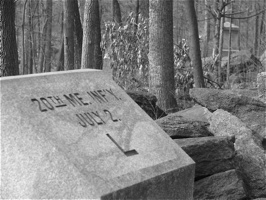 One of my favorite places in Gettysburg is Little Round Top, where Joshua Lawrence Chamberlain defended the Union left flank late on July 2nd, 1863. Chamberlain commanded the 20th Maine Regiment of Vincent’s Brigade that hot July afternoon. Around 5 p.m, the combined Alabama regiments of the 15th and 47th Alabama attacked Chamberlain’s regiment–around 650 sons of Alabama farmers against 314 sons of Maine fishermen and lumbermen.
One of my favorite places in Gettysburg is Little Round Top, where Joshua Lawrence Chamberlain defended the Union left flank late on July 2nd, 1863. Chamberlain commanded the 20th Maine Regiment of Vincent’s Brigade that hot July afternoon. Around 5 p.m, the combined Alabama regiments of the 15th and 47th Alabama attacked Chamberlain’s regiment–around 650 sons of Alabama farmers against 314 sons of Maine fishermen and lumbermen.
Fortunately, Chamberlain defended the high ground against these determined southerners, who were commanded that day by the courageous hand of William Oates of Abbeville, Alabama. Somehow, Oates lead them in five charges against the Maine position, almost flanking them. Chamberlain had to turn (refuse) his line to avoid the flanking maneuver (the left end of his line pictured above). Running out of ammunition, Chamberlain ordered a bayonet charge which surprised the Alabamians. Oates commented that we all “ran like cattle.” Oates would faint from exhaustion in the retreat–he and has men had walked 25 miles that day before they charged the defended position of Chamberlain. Fortunately for Oates, some of his retreating men had enough energy left to carry him off the battlefield and into the relative safety of the Confederate lines.
After the Civil War, Chamberlain became governor of Maine; Oates became governor of Alabama. Both men illustrated how to lead men in dangerous pursuits. Though we don’t wage war against flesh and blood, we do face a “bloody” fight to death in spiritual places. Our enemies are real. The suffering wounds deep. Victory means setting other people free.
Officers in the Civil War learned these two truths. To lead men in battle, you must care for your men’s welfare and you must show physical courage in battle. In the words of Moses, the one over a congregation must lead in and lead out (Numbers 12:15-17). “To Lead in” is to cause our people to come into a place of community, caring and celebration: “to lead out” means to cause our people to go out into the battle, the fight–most often by demonstrating our own courage at the front of that battle.
Viv Thomas writes about the balance of these two leadership qualities:
Christian leaders have to live within the paradigm of both coming and going. Jesus commanded the church to ‘come unto me all who are weary and heavy laden,’ and to “go into all the world and preach the gospel.” He put us into the context of staying and going; they are intended to be together. Continual staying without going leads to stagnation; continual going without staying leads to exhaustion.
To build movements everywhere, we need to be leaders who balance both care and courage, community and cause. Both are required. They are intended to be together. When Jesus called his disciples to follow him, he challenged them to “be with him and to be sent out to preach the gospel.”
How are you doing at “coming and going” At helping others come in and go out?
(Lessons from Gettysburg Conferences: www.ifproperlyled.com Watch for Fall Conference.)
Leave a Reply